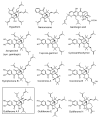A Photoalkylative Fluorogenic Probe of Guttiferone A for Live Cell Imaging and Proteome Labeling in Plasmodium falciparum
- PMID: 33158263
- PMCID: PMC7663766
- DOI: 10.3390/molecules25215139
A Photoalkylative Fluorogenic Probe of Guttiferone A for Live Cell Imaging and Proteome Labeling in Plasmodium falciparum
Abstract
Guttiferone A (GA) 1, a polycyclic polyprenylated acylphloroglucinol (PPAP) isolated from the plant Symphonia globulifera (Clusiaceae), constitutes a novel hit in antimalarial drug discovery. PPAPs do not possess identified biochemical targets in malarial parasites up to now. Towards this aim, we designed and evaluated a natural product-derived photoactivatable probe AZC-GA 5, embedding a photoalkylative fluorogenic motif of the 7-azidocoumarin (AZC) type, devoted to studying the affinity proteins interacting with GA in Plasmodium falciparum. Probe 5 manifested a number of positive functional and biological features, such as (i) inhibitory activity in vitro against P. falciparum blood-stages that was superimposable to that of GA 1, dose-response photoalkylative fluorogenic properties (ii) in model conditions using bovine serum albumin (BSA) as an affinity protein surrogate, (iii) in live P. falciparum-infected erythrocytes, and (iv) in fresh P. falciparum cell lysate. Fluorogenic signals by photoactivated AZC-GA 5 in biological settings were markedly abolished in the presence of excess GA 1 as a competitor, indicating significant pharmacological specificity of the designed molecular probe relative to the native PPAP. These results open the way to identify the detected plasmodial proteins as putative drug targets for the natural product 1 by means of proteomic analysis.
Keywords: 7-azidocoumarin; Guttiferone A; Plasmodium falciparum; fluorogenesis; photoactivation.
Conflict of interest statement
The authors declare no conflict of interest nor competing financial interest.
Figures






Similar articles
-
Synthesis of novel guttiferone A derivatives: in-vitro evaluation toward Plasmodium falciparum, Trypanosoma brucei and Leishmania donovani.Eur J Med Chem. 2013 Jul;65:284-94. doi: 10.1016/j.ejmech.2013.04.066. Epub 2013 May 10. Eur J Med Chem. 2013. PMID: 23727538
-
Antiplasmodial benzophenone derivatives from the root barks of Symphonia globulifera (Clusiaceae).Phytochemistry. 2010 Jun;71(8-9):964-74. doi: 10.1016/j.phytochem.2010.03.008. Epub 2010 Mar 29. Phytochemistry. 2010. PMID: 20356612
-
Fractionation and identification of proteins by 2-DE and MS: towards a proteomic analysis of Plasmodium falciparum.Proteomics. 2005 Nov;5(16):4213-22. doi: 10.1002/pmic.200401285. Proteomics. 2005. PMID: 16196089
-
Protein targeting from malaria parasites to host erythrocytes.Traffic. 2005 Aug;6(8):706-9. doi: 10.1111/j.1600-0854.2005.00310.x. Traffic. 2005. PMID: 15998325 Review.
-
Extensive differential protein phosphorylation as intraerythrocytic Plasmodium falciparum schizonts develop into extracellular invasive merozoites.Proteomics. 2015 Aug;15(15):2716-29. doi: 10.1002/pmic.201400508. Epub 2015 May 19. Proteomics. 2015. PMID: 25886026 Review.
Cited by
-
Unravelling the Puzzle of Anthranoid Metabolism in Living Plant Cells Using Spectral Imaging Coupled to Mass Spectrometry.Metabolites. 2021 Aug 25;11(9):571. doi: 10.3390/metabo11090571. Metabolites. 2021. PMID: 34564386 Free PMC article.
-
Uncovering the Mechanism of Action of Antiprotozoal Agents: A Survey on Photoaffinity Labeling Strategy.Pharmaceuticals (Basel). 2024 Dec 28;18(1):28. doi: 10.3390/ph18010028. Pharmaceuticals (Basel). 2024. PMID: 39861091 Free PMC article. Review.
References
-
- WHO . World Malaria Report 2019. World Health Organization; Geneva, Switzerland: 2019. pp. 1–232.
-
- Imwong M., Suwannasin K., Kunasol C., Sutawong K., Mayxay M., Rekol H., Smithuis F.M., Hlaing T.M., Tun K.M., Van Der Pluijm R.W., et al. The spread of artemisinin-resistant Plasmodium falciparum in the Greater Mekong subregion: A molecular epidemiology observational study. Lancet Infect. Dis. 2017;17:491–497. doi: 10.1016/S1473-3099(17)30048-8. - DOI - PMC - PubMed
MeSH terms
Substances
LinkOut - more resources
Full Text Sources

